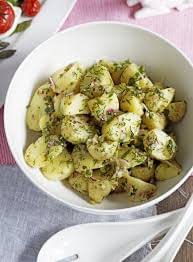Have you ever notice that some foods keep you feeling full longer? And others give you the munchies an hour later? That can make the advice to “stop eating when you feel full” a bit tricky if you’re picking foods that aren’t filling.
That’s a phenomenon called satiety. It’s the feeling of fullness, of being satisfied and satiated. It’s is the opposite of hunger and appetite.
The satiety index is a rating of foods that have been tested for the satiating effect in a 240 calorie (1,000 kJ) portion size. The scale scores foods based on whether people feel extremely hungry, hungry, semi-hungry, no feeling, semi-satisfied, satisfied, or extremely satisfied. Similarly to the glycemic index, the response to white bread was set to be 100. Foods that are more filling have numbers higher than 100. Foods that are less filling have numbers lower than 100.
What foods keep you feeling full for longer?
- Boiled potatoes (323);
- Fish (225);
- Oatmeal/Porridge (209);
- Oranges (202);
- Apples (197);
- Brown rice pasta (188);
- Beef steak (176);
- Baked beans (168);
- Eggs (150);
Some foods that score lower than white bread (100) on the satiety index are:
- Ice cream (96);
- Chips (91);
- Yogurt (88);
- Peanuts (84);
- Mars bar (70);
- Doughnuts (68);
- Cake (65);
- Croissant (47).
If you want to feel full and more satiated, then choose foods from the first list that score more than 100 and combine them together Protein-Fat-Fiber:
- Protein is considered to be more filling than either carbohydrates or fats by themselves.
- Because fiber is not digested, it provides bulk. This bulk tends to help you feel full longer because it slows down emptying of the stomach and digestion time.
- Highly satiating foods tend to have more volume for the same amount of calories; this means they tend to take up more space with water or air.
- You need to add some fat to absorb fat-soluble nutrients.
- Highly satiating foods are also generally whole and less processed.
If you think about the feeling of fullness, it makes you not want to eat at that moment. It wards off the feeling of hunger. Eating more foods that have a higher satiety index are more filling, and therefore can help you to eat less overall.
This is one strategy to use if you feel hungry all the time, or if you’re trying to lose weight.
Conclusion
The satiety index is a measure of how filling and satisfying food makes you feel. The higher the score, the fuller you feel. Eating foods that score higher on the satiety index can help reduce food intake.
Satisfying (satiating) food combinations tend to be protein-rich, fibre-rich, have some fat, whole, less processed foods. Things like boiled potatoes, fish, oats, veggies, fruit, meat, and legumes.
Foods that are not very satiating tend to be higher in carbohydrates, fat, and are more processed; things like ice cream, chips, doughnuts, cakes, and croissants.
If you want to feel full longer, then choose more foods that are highly satiating and fewer foods that are not.
Recipe (Highly satiating): Not your average boiled potatoes
Serves 6-8
2 lbs mini potatoes
2 cloves garlic, minced
1 cup vegetable stock
1/4 tsp salt
1/4 tsp black pepper
1 tbsp fresh chives (or 1 tsp dried)
1 tbsp fresh parsley (or 1 tsp dried)
½ tbsp fresh thyme (or 1 tsp dried)
Instructions:
In large pot place potatoes, garlic, stock, salt & pepper. Cover and bring to boil and simmer for 15 minutes.
Check potatoes by piercing gently with a fork. Add more water if needed.
When done toss with herbs. You can add some butter or sour cream (1-2 table spoons) .
Serve & enjoy with a protein (fish, meat or vegetarian protein) and a veggie salad and you will have your very satisfying Protein-Fat-Fiber combination!
Tip: You can drizzle with a touch of olive oil if you like.
References:
https://en.wikipedia.org/wiki/Satiety_value
http://www.healthline.com/nutrition/15-incredibly-filling-foods#section1
http://www.healthline.com/nutrition/foods-you-can-eat-a-lot-of
https://www.researchgate.net/publication/15701207_A_Satiety_Index_of_common_foods

